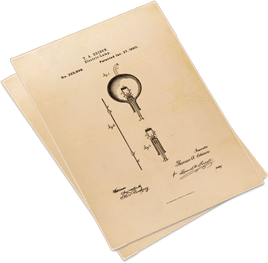Q: When is an Internet domain name a trademark?
A: When it’s used as a trademark.
An Internet domain name is an address, a location in cyberspace. It is not in and of itself a trademark or a service mark. Like “151 Newbury Street, Portland, Maine” and “30 Rockefeller Plaza, New York, New York” in physical space, the Internet address says where something is located in what we’ve come to know as virtual space. It enables your Web browser, electronic mail client, FTP (file transfer protocol) client, and other Internet software to find the place and (virtually) take you there.
In some ways an Internet domain name is like a telephone number. It’s what you key into your Internet software to remotely connect to a Web site or other file server without leaving the comfort of your own space. Still, in common parlance and thought, we “go to” places in cyberspace, often for the same purpose we go to the department store and the Post Office.
Having the right address has always been important, socially, politically, and commercially. Location. Location. Location. Customers have to be able to find you, and the easier, the better. For that reason it has long been the practice of those who could afford it to put their own names on the places where they live and work, and countless streets, plazas, and villages, and a few mountains, have the name of the family or company that first settled there. In business, the practice has led to, for example, John Hancock Buildings in several cities to house the offices of the John Hancock Mutual Life Insurance Company, and to Hershey, Pennsylvania, where you don’t have to guess who has been the largest employer. A conspicuous address also helps to promote a business or brand name and may enhance the image of companies and brands, leading to places like The Staples Center in Los Angeles. You don’t go there to pick up paper clips, but the many who go there or hear about it on TV and radio, and in newspapers, are reminded of the name of the place near them where they can buy paper clips, poster board, and printers.
When someone figured out that telephone numbers were better remembered as words, it became unnecessary to wait for someone to go out of business to get hold of the few easy-to-remember number combinations like 765-4321 and 555-5000. Almost any series of seven digits meant to be punched on a telephone keypad can be turned into a memorable relevant word or phrase. Most IRS telephone numbers have an 829 (TAX) exchange, and its main number is 1-800-TAX-1040. 1-800-KEY2YOU reaches Key Bank, and 1-888-GO FEDEX connects you to Federal Express.
And so this sort of thing was natural when businesses and organizations began occupying Internet domains. The actual inter-network addresses are four binary bytes represented somewhat intelligibly by a set of four dot-separated base-10 numbers, each with a value in the range of zero to 255, such as 207.43.134.9. Names were associated with these number-sets early on in the development of the Internet, because the numbers were virtually impossible for ordinary mortals to remember, and as soon as the Web became a place of commerce, these names — domain names — became valuable commodities. If your domain name reflects your company name or a product brand name, then potential customers may find your Web site more easily and better remember how to direct others to you.
Uses of addresses and phone numbers as addresses and phone numbers, however, no mattrer how prominent on buildings and road maps, in telephone listings and Internet search engines, generally do not create trademarks and trademark rights. John Hancock? is a service mark for insurance and financial services; its not a brand of building. Hershey’s? is a trademark for candy, and not a service mark for city planning services. Such uses of trademarks and service marks are promotional and convenience uses, not trademark uses, in the same way that the Budweiser logo emblazoned over the front of a t-shirt advertises the beer sold under that trademark and doesn’t identify a line of Budweiser-brand clothing.
For a domain name to be a trademark (or service mark), the same rule applies to it as applies to any other matter or device you want to be a trademark: the domain name must be used in the manner of a trademark in connection with particular goods or services to identify the particular source of the goods or services.

On the other hand, if you ask someone where she got the book she’s reading, she may well reply “amazon-dot-com,” because amazon.com? is a service mark identifying particular retail sales services. The “label” amazon.com, not simply amazon, appears on the place where the services are provided and on the packages the company sends you.
*Note: MOUNTAIN DEW is a registered marks of PepsiCo, Inc.
AMAZON.COM is a registered mark of Amazon.com, Inc.
JOHN HANCOCK is a registered mark of John Hancock Mutual Life Insurance Company
HERSHEY’S is a registered mark of Hershey Chocolate & Confectionery Corporation
BUDWEISER is a registered mark of Anheuser-Busch, Incorporated
1-800-KEY2YOU is a registered mark of KeyCorp
1-888-GO FEDEX is a registered mark of Federal Express Corporation


